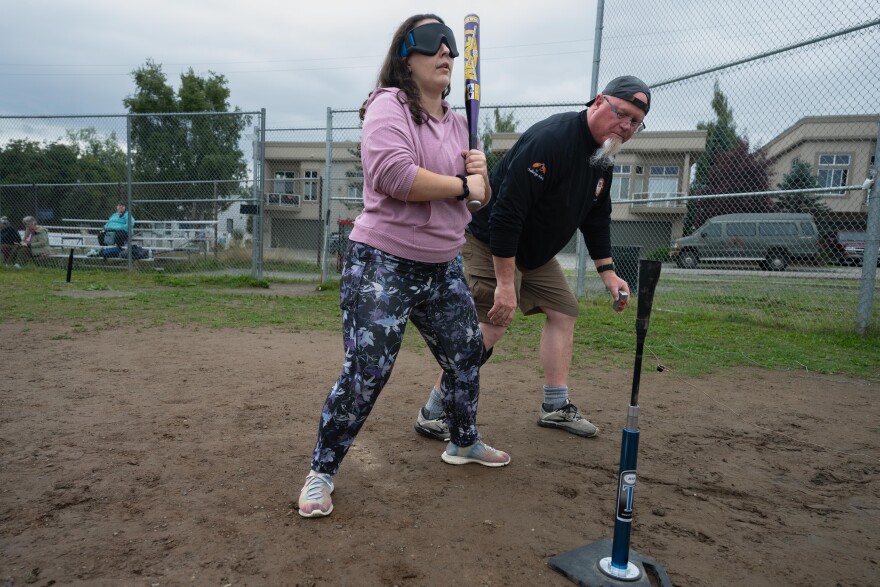Tom Class stood at home plate, waiting for a baseball he couldn't see.
Instead, he listened.
He was playing a version of baseball called “beep ball.” Class is visually impaired, just like most of the people in the field. The game is named for the sound the ball makes, but beeps aren’t the only sound involved. The bases buzz, and there’s a whole lot of communication, like when the pitcher, who’s sighted, lets everyone know when they’re about to lob the ball, calling out “Ready, set, pitch!” The sounds and communication help the athletes know exactly what’s going on, and when to spring into action.
It may seem like there’s no sport less likely to work for the visually impaired than baseball. But the rules are quite a bit different. To minimize collisions in the field, players run to just one base, waiting for the buzzing that tells them whether to head toward first or third. And fielding is different too. Athletes aren’t trying to catch fly balls. Instead, the goal is to scoop the ball off the ground and hold it up in the air before the batter makes it to the base.
When a game is modified so people with disabilities can play, it’s called an "adaptive" sport. Organizers say access to recreation is important, part of a healthy lifestyle. It also teaches communication, teamwork, how to win and lose gracefully, and how to problem-solve. And, importantly, it can be really fun.

After his at-bat, Class headed back to the outfield. That part's tough, he said. It’s hard to find a ball in the field using just the beeping to locate it.
“I’m not good at it yet,” he said, laughing.
There’s some strategy involved. It’s better to stay on your feet, he said, because that gives you more agility. But sometimes the temptation to dive for the ball is too much.
“That's a gamble, because if you miss the dive, then you're on the ground, the ball just rolls past you,” he said. “It’s like ‘Ahhh! I have to get back up and chase the ball again!’”
It takes practice, and this is only the fourth time they’ve gotten together this summer. Unfortunately, it’ll also be the last.
That’s because this season has kind of been a test run, to gauge whether there’s interest. Beep ball used to be organized by the Lions Club, but that fizzled out awhile ago. This season, the nonprofit Challenge Alaska organized the sport. And there is a lot of enthusiasm, according to Jeff Dick, a recreational therapist with the organization. The players are having a great time, he said.

He’s not surprised though. It’s something he sees a lot with Challenge Alaska’s adaptive sports programs.
“You show them something they never thought they could do,” he said. “Or never thought would be available to them again, and they learn, ‘Not only can I do this, but I can excel at it. I can have fun. I can connect and be a part of a community like I can be a part of a team. I can be a part of something greater than myself.’”
Alaskans of all abilities deserve the access to activities like skiing, hiking, and basketball that Challenge Alaska provides, Dick said.
“Telling somebody you can't play baseball just because you're blind, you can't do track and field just because you can't use your legs — go ahead and say that, we're going to prove you wrong,” he said.

Back in the baseball diamond, Dick helped Kelsy Tallant with her stance. It can be complicated, he said. How do you explain to somebody how to swing a baseball bat when they've never seen it done before?
Tallant agreed.
“Being a blind person, I don't know much about regular baseball,” she said, laughing.
But she kept at it, determined to get it right.
“Bend your knees. Don't swing with straight knees, you'll hate it!” Dick told her.
She took a few more practice swings, and she was ready.
The pitcher called out, “Ball in play!” and tossed it squarely over the plate.
And then, with a sharp crack, her bat made contact with the ball.
Tallant charged down the first base line. She stretched her arms wide, feeling for the buzzing foam pillar that is first base. She connected, and launched into a dive. She came up grinning.
“I did a slide!” she yelled to her teammates. “It was awesome!”
For Tallant, playing on a team is about connecting with other people. She said she’s made lifelong friends participating in adaptive sports. Some of them were with her on the field.

When practice was over, the players clustered together close to home plate. Tallant was so bummed the season was over, she said she felt like crying. But she joked off her sadness as she pulled everyone together for a cheer.
“Hands in,” she called. “Act like we like each other! On three — Go team!”
They all pushed in close.
“One, two, three! Go team!” they shouted.


